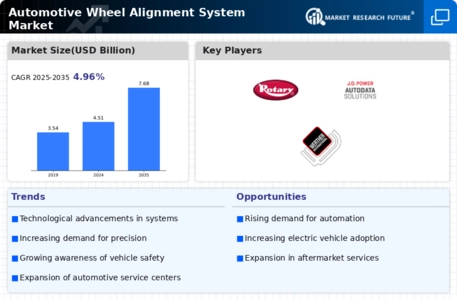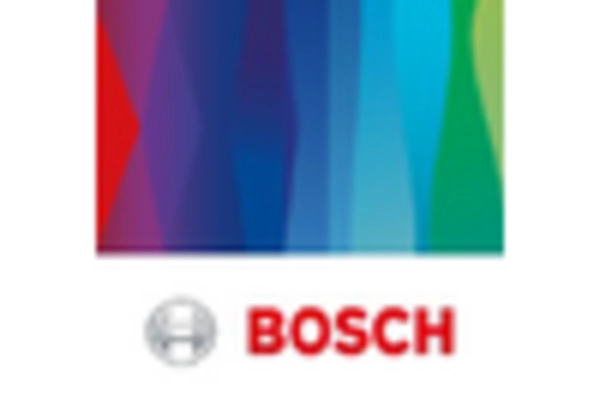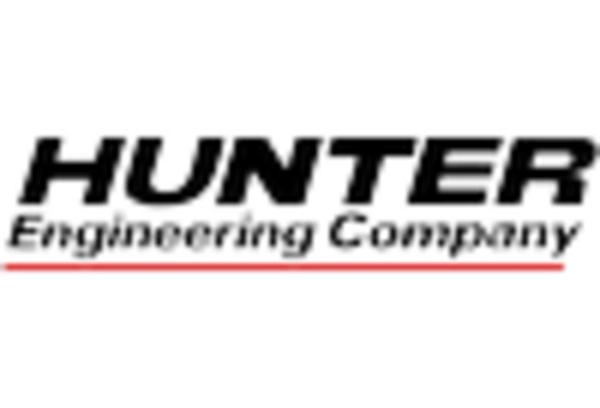Expansion of Service Centers and Workshops
The expansion of automotive service centers and workshops is a crucial driver for the Automotive Wheel Alignment System Market. As the number of vehicles on the road continues to grow, the demand for alignment services is increasing correspondingly. Data suggests that the number of independent service centers has risen by 15% over the past three years, providing consumers with more access to alignment services. This proliferation of service facilities is likely to enhance competition, leading to improved service quality and pricing strategies. Moreover, many service centers are now incorporating advanced alignment technologies, which could further attract customers seeking efficient and reliable services. Consequently, the expansion of service centers is expected to play a pivotal role in the growth of the Automotive Wheel Alignment System Market.
Regulatory Standards and Safety Regulations
Regulatory standards and safety regulations are becoming increasingly stringent, influencing the Automotive Wheel Alignment System Market. Governments are implementing more rigorous vehicle safety standards, which often include requirements for proper wheel alignment. Compliance with these regulations is essential for automotive service providers, as failure to adhere could result in penalties or loss of business. Recent legislative changes have emphasized the importance of vehicle safety, leading to a heightened focus on alignment services. As a result, service providers are likely to invest in advanced alignment systems to ensure compliance and enhance safety. This trend is expected to drive demand within the Automotive Wheel Alignment System Market, as businesses strive to meet regulatory requirements while providing high-quality services.
Growth in Electric and Hybrid Vehicle Segment
The growth of the electric and hybrid vehicle segment is emerging as a significant driver for the Automotive Wheel Alignment System Market. As more consumers opt for electric and hybrid vehicles, the need for specialized alignment services tailored to these vehicles is becoming apparent. Data indicates that the market share of electric vehicles has increased by over 30% in recent years, necessitating the adaptation of alignment technologies to accommodate different weight distributions and suspension systems. This shift presents an opportunity for service providers to invest in advanced alignment systems that cater specifically to electric and hybrid models. Consequently, the rise of this segment is likely to contribute positively to the Automotive Wheel Alignment System Market, as businesses seek to capitalize on the growing demand for specialized services.
Increased Consumer Awareness of Vehicle Maintenance
Consumer awareness regarding the importance of regular vehicle maintenance is on the rise, significantly impacting the Automotive Wheel Alignment System Market. As drivers become more informed about the benefits of proper wheel alignment, including improved fuel efficiency and tire longevity, the demand for alignment services is likely to increase. Recent surveys indicate that approximately 60% of vehicle owners now recognize the correlation between wheel alignment and overall vehicle performance. This heightened awareness is prompting consumers to seek professional alignment services more frequently, thereby driving growth in the market. Additionally, educational campaigns by automotive organizations are further reinforcing the significance of regular maintenance, which is expected to sustain the upward trajectory of the Automotive Wheel Alignment System Market.
Technological Advancements in Automotive Wheel Alignment Systems
The Automotive Wheel Alignment System Market is experiencing a surge in technological advancements, which are enhancing the precision and efficiency of alignment processes. Innovations such as 3D imaging and laser alignment systems are becoming increasingly prevalent, allowing for more accurate measurements and quicker service times. According to recent data, the adoption of advanced alignment technologies has led to a 20% reduction in service time, which is appealing to both service providers and consumers. Furthermore, the integration of software solutions that provide real-time diagnostics and analytics is likely to improve customer satisfaction and operational efficiency. As these technologies continue to evolve, they are expected to drive growth in the Automotive Wheel Alignment System Market, as businesses seek to differentiate themselves through superior service offerings.


















Leave a Comment